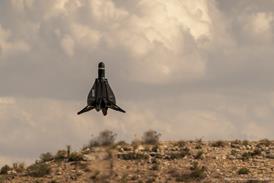Boeing and Lockheed Martin gird up for JSF fight
Stewart Penney/LONDON
Assuming funding difficulties do not kill the programme, or at least slow it to a snail's pace, the first flights of Boeing's X-32 and Lockheed Martin's X-35 will be the most significant events of 2000. The pair are competitors in the Joint Strike Fighter (JSF) programme to replace Lockheed Martin F-16s, Boeing F/A-18s and Boeing AV-8s as well as British Aerospace Harriers and Sea Harriers.
The programme promises to shape the Western world's armed forces and fighter industry for the first half of the new century. The winner will gain orders for about 3,000 aircraft in three versions:
• a conventional take-off aircraft for the US Air Force;
• a carrier-compatible aircraft for the US Navy;
• a short take-off/vertical-landing variant for the US Marine Corps and the UK services.
Flight trials in 2000 will lead to the drawing up of a shortlist in 2001.
Also in the USA, Boeing will strive to achieve a single production order for 222 F/A-18E/F Super Hornets. A single five-year batch, rather than the traditional approach of small annual quantities, promises to be more efficient and, therefore, cheaper. It would also bring stability to production lines at Boeing's St Louis military-aircraft operation. Moving forward with a five-year procurement is dependent upon a positive operational evaluation report, due in January. While F/A-18E/F production ramps up, the co-located F-15 Eagle line is coming to an end, with only a small USAF attrition order sustaining production. A win in the South Korean F-X fighter competition is crucial for continued F-15 production.
Meanwhile, Lockheed Martin will hope that the USAF buys its C-130J tactical transport, which will stabilise the line and guarantee its continued operation once orders from Australia, Italy and the UK have been fulfilled.
The Lockheed Martin/Boeing F-22 Raptor - the fourth prototype of which will fly next year - will continue to face deep scrutiny on Capitol Hill, which threatened the programme this year. If key milestones are not met as laid down in the lawmakers' funding criteria, the programme could encounter significant challenges.
Other aircraft that theoretically could make first flights next year include Russia's MAPO 1.42 stealth demonstrator. An initial outing for India's Light Combat Aircraft has been on the cards for several years, but technical difficulties and US sanctions have kept the aircraft on the ground.
In Europe, Norway's fighter competition should come to a conclusion in 2000. While an order for up to 30 fighters may not normally be important, this particular competition is highly significant because Norway is the first country to assess Eurofighter's Typhoon against the F-16. A victory in Norway for the European consortium would be a breakthrough as Norway already operates F-16s and such a win could open the door to other F-16 operators, particularly the early European operators.
Arming the Eurofighter is at the centre of one of the most heated procurement battles in years. The UK is expected to decide in February between a Raytheon bid based on stepped development of its AIM-120 Advanced Medium Range Air-to-Air Missile and the Meteor, a Matra BAe Dynamics (MBD) proposal for a ramjet-powered missile. MBD's team includes companies from the other Eurofighter nations - Germany, Italy and Spain - as well as France and Sweden, which produce Europe's other fourth-generation fighters, the Dassault Rafale and Saab's Gripen.
MBD argues that a win would ensure that the USA does not maintain a long-range AAM monopoly, and that it will prevent the USA from blocking Typhoon sales by embargoing orders for the aircraft's weapons. Raytheon has strong US Government support and is offering joint UK/US long-range missile development. It is seeking to bypass export-ban concerns by offering a joint decision-making committee.
The UK is the lead decision-making country. Once it has announced its choice, five other European capitals are due to follow suit.
A similar situation surrounds Europe's future transport needs. Seven countries have committed to the Future Transport Aircraft: Belgium, France, Germany, Italy, Spain, Turkey and the UK. Each is considering various solutions, including the Airbus Military Company A400M, the Boeing C-17 Globemaster, the C-130J and a Westernised version of the Antonov An-70, the An-7X. Again, a decision by the UK against the pan-European offering - in this case the A400M - could effectively kill the programme.
Helicopter competitions are also ready to be concluded in 2000. The Nordic Standard Helicopter programme brings together Denmark, Finland, Norway and Sweden, which are seeking a single type to replace diverse machines in the transport, search and rescue, anti-submarine warfare and shipborne roles. Lead competitors include the EH Industries EH101, Eurocopter Cougar, NH Industries NH90 and Sikorsky S-92. The NH90's effort may be harmed if Germany, a major partner, does not sign up to the production phase, as is expected during the Berlin air show in May - almost a year later than planned.
Two other helicopter competitions that are likely to be resolved in 2000 include Australia's Air 87 combat machine and Turkey's attack helicopter requirements. The former could be in difficulty following a legal challenge, on cost grounds, from Bell Helicopter Textron.
Its A-1Z was not shortlisted, although the Agusta A129 Scorpion, Boeing AH-64D and Eurocopter Tiger were. Turkey has shortlisted the same helicopters as well as a Kamov/Israel Aircraft Industries proposal, the Ka-50-2, a two-seat tandem version of the single-seat Ka-50 with Israeli sensors and avionics.
The damage caused by earthquakes in Turkey could postpone, or severely cut back, the initial order from a planned 145 machines to about 20.
Source: Flight International























